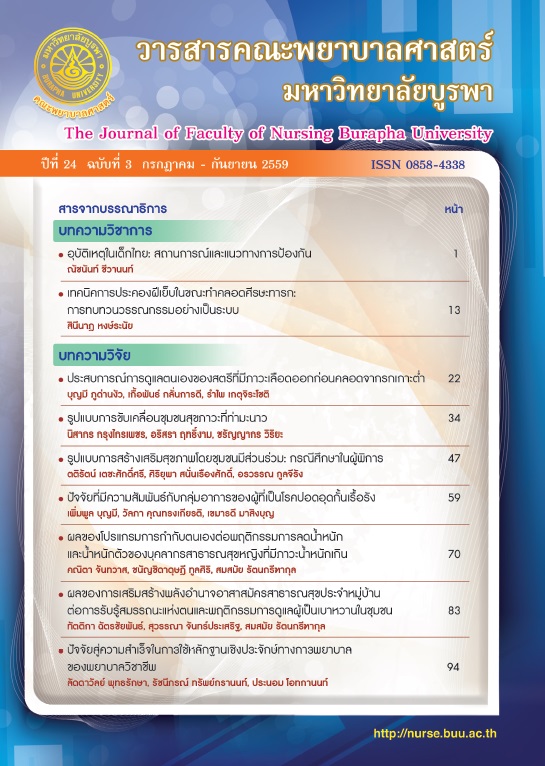รูปแบบการขับเคลื่อนชุมชนสุขภาวะที่ท่ามะนาว
คำสำคัญ:
ชุมชนสุขภาวะ, การสร้างเสริมสุขภาพ, พยาบาลชุมชน, Healthy community, health promotion, community nurseบทคัดย่อ
บทคัดย่อ
การวิจัยนี้เป็นการวิจัยเชิงคุณภาพเพื่อศึกษารูปแบบการขับเคลื่อนชุมชนท่ามะนาวสู่ชุมชนสุขภาวะ และสมรรถนะของพยาบาลชุมชน ที่เป็นตำบลต้นแบบทั้งในเรื่องการสร้างเสริมสุขภาพ การรักษ์พลังงาน การพัฒนาภูมิปัญญาท้องถิ่น ตลอดจนการพัฒนาคุณภาพชีวิต ใช้ยุทธศาสตร์กฎบัตรการสร้างเสริมสุขภาพออตตาวา เป็นกรอบแนวคิดในการศึกษา ผู้ให้ข้อมูลได้แก่ องค์กรชุมชนที่มีหน้าที่ในการจัดการสุขภาพชุมชน และภาคประชาชน รวมจำนวนทั้งสิ้น 18 คน โดยใช้วิธีบอกต่อในการเลือกผู้ให้ข้อมูลที่เกี่ยวข้อง เก็บรวบรวมข้อมูลโดยวิธีสนทนากลุ่ม สัมภาษณ์เชิงลึก ประชุมกลุ่มย่อย ศึกษาดูงานกลุ่ม/ ศูนย์การเรียนรู้ในชุมชน สังเกต บันทึกภาพและเสียงการสนทนา และศึกษาจากเอกสารที่เกี่ยวข้อง ตรวจสอบความถูกต้องและความหลากหลายโดยใช้วิธีเปรียบเทียบข้อมูลเรื่องเดียวกันหลายวิธี และจากหลายแหล่ง ผู้รวบรวมข้อมูลหลายคน และต่างช่วงเวลากัน และใช้วิธีการวิเคราะห์แก่นสาระ
ผลการศึกษาพบว่า รูปแบบการขับเคลื่อนเริ่มต้นจากการวิเคราะห์ข้อมูลปัญหาของชุมชน นโยบายของผู้นำส่วนท้องถิ่น การหนุนเสริมศักยภาพชุมชนจากองค์กรภายนอก กระบวนการขับเคลื่อนประกอบด้วยการพัฒนาศักยภาพคนให้พึ่งพาตนเองได้ การระดมทุนความรู้ของชุมชนและทุนเงินจากภายนอกชุมชน การพัฒนาระบบบริหารจัดการจนเกิดระบบการบริหารจัดการที่มีธรรมาภิบาลบนมุมมองการบูรณาการงานทุกมิติ จนเกิดชุมชนจัดการตนเองทั้งด้านสุขภาพและการดำเนินชีวิต เกิดการรวมกลุ่มที่หลากหลายในชุมชน มีการสืบทอดสู่คนรุ่นใหม่ กระบวนการขับเคลื่อนได้สะท้อนให้เห็นภาพการสร้างเป้าหมายร่วมกันของแกนนำชุมชน ความสามัคคีของแกนนำ การมุ่งเน้นการเรียนรู้ของชุมชนมากกว่าผลสำเร็จเชิงปริมาณ การสะท้อนข้อมูลแก่ชุมชน การปรับกิจกรรมผ่านเวทีถอดบทเรียน เหล่านี้ส่งผลให้เกิดการปรับกลยุทธ์ในการพัฒนาอย่างต่อเนื่อง โดยมีพยาบาลวิชาชีพประจำโรงพยาบาลส่งเสริมสุขภาพตำบลเป็นผู้ประสานเชื่อมโยงร้อยความคิดของทุกภาคส่วนทั้งในและนอกชุมชน ผลของการวิจัยสามารถนำไปประยุกต์ใช้ในการเสริมสร้างชุมชนสุขภาวะ และเป็นแนวทางในการพัฒนาศักยภาพของพยาบาลชุมชนในการสร้างเสริมชุมชนให้มีความเข้มแข็งต่อไป
Abstract
This qualitative research aimed to study the driven model of healthy community in Thamanow and competency of community nurse. This community was a role model of health promotion, energy conservation, and a development of local wisdom, and quality of life. The Ottawa charter for health promotion strategy was applied to be a conceptual framework of the study. The 18 participants were community organizations who taking care community health and civil society and were selected by using snowball sampling technique. Data collection techniques included focus group, in-depth interview, small group meeting, visiting learning centres in community, observation, related photos study and voice recording, and documentary study. The data were validated by triangulate method. Thematic analysis was exploited for analyzing data.
The results showed that the driven model was beginning with analyzing community’s problems, policy of local leaders, and supporting from organizations outside community. The driven process were human’s capacity building to be self-reliance, collecting local wisdom and raising fund from organizations outside community, developing management system to be in a good governance way through the perspective of integrated every dimensions. The outcomes of the development were community self governance both in health and lifestyle aspects, gathering of particular groups in community, and passing the explicit knowledge to young generation. The process reflected the setting goal of key persons in community, agreement of key man, focusing on community learning more than the quantitative outputs, reflection data to community, and the improving activities through discussion among committee meetings. These activities encouraged committees to improve their strategies on the continuing development cycle by the nurse working in primary care unit who was the main person in coordinating, advocating, and collaborating every partnership both inside and outside community. These findings could be applied for strengthen healthy community and be a guideline for reinforcing community nursing’s capacity.





